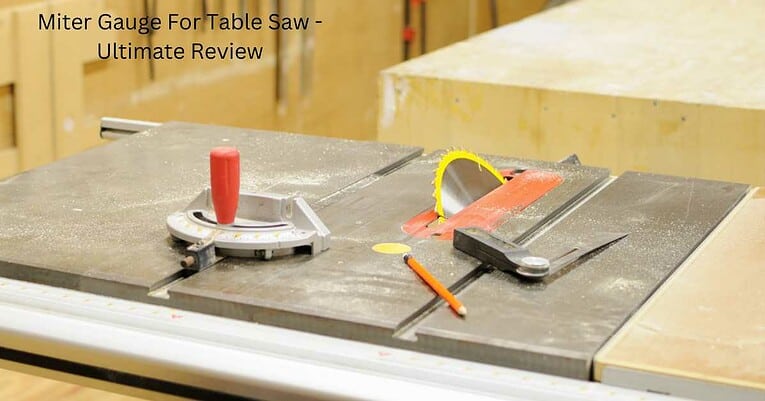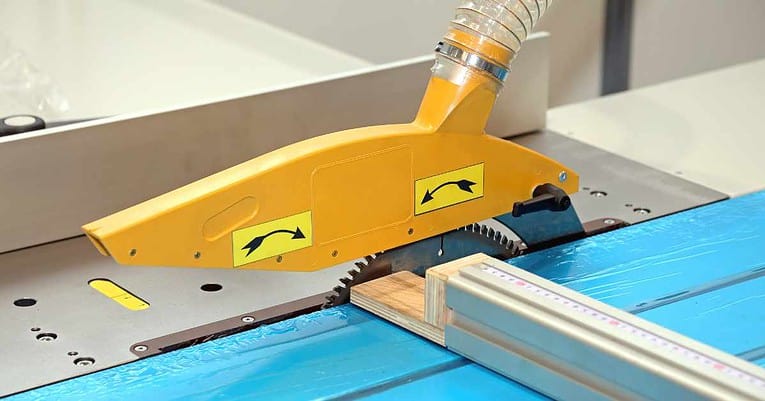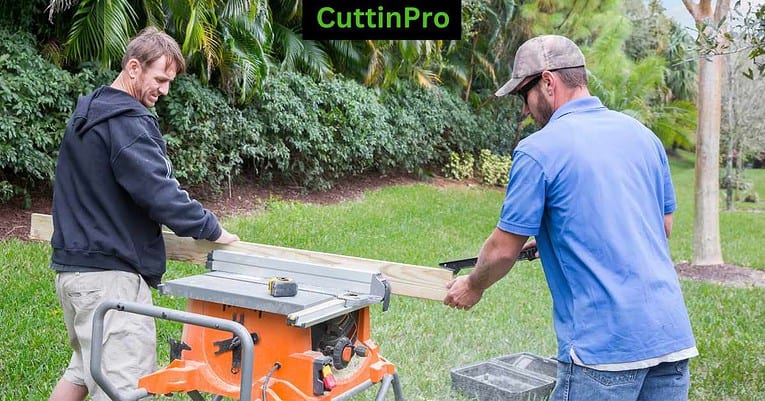How to use a table saw safely? – Step By Step (Beginner Guide)
Are you looking to take your next carpentry mission up a notch? If so, using a table saw is an essential skill for experienced DIYers and those new to the workshop. However, with its blades possessing immense power, we must heed proper safety techniques to prevent accidents. Studies conducted by the Consumer Product Safety Commission have revealed that table saws are responsible for more than 40,000 injuries annually in America alone. To ensure the successful completion of your task without incident or injury, read below for tips on how to use a table saw safely and securely.
How to use a table saw safely? (Essential Safety Equipment)
It is necessary to equip yourself with the proper safety equipment before using a table saw, as this can help protect you from injury in an emergency. Make sure that you have on hand all of these must-have items for optimal security:
- Safety Glasses or Goggles: Protect your eyes from flying debris and sawdust.
- Dust Mask or Respirator: To prevent inhaling harmful particles from the sawdust created during the cutting process.
- Earplugs: To protect your hearing from the loud noise generated by the saw.
- Heavy-Duty Gloves: To protect your hands from cuts and injury.
- Push Sticks: To safely push the wood through the blade, keep your hands away from the dangerous area.
- Kickback Pawls: A device that attaches to the saw to prevent the wood from being thrown back toward the operator.
- Riving Knife: A device that helps prevent the wood from binding on the blade and reduces the risk of kickback.
- Blade Guard: A protective cover that fits over the blade to avoid injury and to contain sawdust.
Preparing the Work Area
Before you start cutting, preparing your work area is crucial to ensure maximum safety. Here are some essential steps to follow:
Clear the Work Surface and Surrounding Area: Ensure the table saw and surrounding area is free of debris, tools, or other objects that might get in the way or cause tripping hazards. This will help you move around freely and prevent accidents.
Check for Tripping Hazards or Obstructions: Take a look around the work area and ensure there are no loose cords or anything else that could cause you to trip. This is especially important if you will be moving around the saw frequently.
Please ensure the Saw is Level and Secure: Before using your saw, make sure it is level and secure on the table. This will help prevent it from moving or tipping over while in use. Use bolts or clamps to secure the saw if necessary.
How to Use Table Saw Safely? (And Setting up the Table Saw Correctly)

Before using your saw, please read our guideline that how to use table saw safely, it’s essential to ensure it’s set up correctly to maximize safety and ensure clean cuts. Here are some steps to follow:
Selecting the Right Blade: The type of blade you use will depend on the type of wood you are cutting and the size of your cuts. Make sure to use a suitable blade for your project and one in good condition. Dull blades can cause the saw to bind and increase the risk of kickback.
Adjusting the Height of the Blade: To ensure a successful cut, ensure the blade is adjusted to the thickness of your material. If you’re cutting thicker components, it’s best to go with a higher blade setting; for thinner items, choose a lower height. Remember to adjust the blade before starting up your saw, and don’t forget about safety – always use the guard.
Installing the Blade Guard and Riving Knife: The blade guard helps to prevent injury by covering the blade when not in use, while the riving knife helps to prevent the wood from binding on the blade. Make sure to install both of these devices before using the saw. Check the manufacturer’s instructions for specific details on how to install these items.
You may also like:
- 10 Best Beginner Table Saws Review
- Best Hybrid Table Saws (Top 10 Reviewed)
- Top 10 Cabinet Table Saw
- How to sharpen a table saw blade?
- Featherboards for Table Saws Review
Preparing the Material
Before making any cuts on your table saw, it’s crucial to prepare the material to ensure accurate cuts and minimize the risk of injury. Here are some steps to follow:
- Measuring and Marking the Material Accteluray: Measure and mark the material to the desired length or width. This will help to avoid any mistakes during the cutting process and ensure accurate cuts. Use a straight edge or a square to make precise markings.
- Checking for Knots and Splinters: Before starting any carpentry work, it is essential to thoroughly inspect the material for knots or splinters that could lead to saw blade binding and potential breakage. If you identify these elements, be sure to plan your cuts properly to avoid potentially hazardous situations. Taking this extra step will help ensure a safe working environment and successful completion of the task.
- Clamping the Material: Clamp the material to the table saw to prevent it from moving while cutting. This will help to ensure straight cuts and reduce the risk of the material sliding and hitting your hands or arms.
- Setting the Fence: If you are making a crosscut, adjust the fence so it is square to the blade. That will help to ensure accurate cuts and reduce the risk of kickbacks.
- By preparing the material, you can make accurate cuts, reduce the risk of injury, and ensure a successful woodworking project.
How to use a table saw safely? (Making the Cut)

Positioning the material correctly: Before making a cut on a table saw, it is crucial to ensure the material is positioned correctly. This involves aligning the material with the blade and fence to ensure a clean, accurate cut. The material should be pushed against the fence while keeping both hands on either side of the material and away from the blade. That will help prevent the material from slipping and moving during the cut.
Using the right push stick for the type of cut: Push sticks are an essential tool for table saw cuts, as they help keep your hands away from the blade and prevent the material from moving during the cut. There are different types of push sticks for different kinds of cuts, such as narrow, wide, and irregular. When selecting a push stick, choosing one appropriate for the type of cut being made is essential.
Keeping your hands away from the blade and material: Keeping your hands away from the blade and material is one of the most important safety precautions when using a table saw. This can be achieved by using a push stick, keeping both hands on either side of the material and away from the blade, and wearing gloves if necessary.
Moving slowly and steadily through the cut: Moving slowly and steadily through the cut is vital for a clean and accurate cut. This involves making a smooth and consistent motion through the material without stopping or pausing during the cut. Moving too quickly can cause the blade to catch the material and cause it to move or bind, leading to an inaccurate cut.
Comparison and reviews articles:
- Which One Should You Buy First – Miter Saw or Table Saw?
- Best budget table saw under $1000
- Metabo Table Saw Review and Ultimate Guide
Dealing with Kickback
Kickback is a dangerous and potentially life-threatening situation that can occur when using a table saw or any other power tool. Kickback occurs when a piece of wood gets caught in the blade and is suddenly thrown back toward the operator. The speed and force of the kickback can cause severe injury or even death if not handled properly.
Understanding the causes of kickback:
Kickback is caused by various factors, including the type of wood used, the blade’s dullness, and the angle at which the wood is cut. When wood fibers are cut at an angle, they tend to bind together and can get caught in the blade, causing a sudden and forceful kickback. Other factors, such as using a dull blade or not using a riving knife, can contribute to the likelihood of kickback.
Taking preventive measures such as using a riving knife and push sticks:
Several preventive measures can be taken to reduce the risk of kickbacks. Using a riving knife, a device attached to the saw that helps prevent the wood from getting caught in the blade is one of the most effective measures. Using push sticks to guide the wood through the blade can also reduce the risk of kickback, as they help keep the operator’s hands away from the blade.
How to Use Table Saw Safely Being prepared to quickly and safely react if kickback occurs:
Despite taking preventive measures, there is always a risk of kickback occurring. In the event of a kickback, it is vital to be prepared to quickly and safely react. This means clearly understanding the proper response techniques and having the necessary equipment and training. The first step in responding to kickback is to remain calm and focus on controlling the saw. This can be achieved using a grip that provides maximum control, such as a two-handed grip. If kickback occurs, it is also important to quickly release the trigger and turn off the saw to stop the blade from spinning.
Maintaining the Table Saw
How to use table saw safely?: Maintaining a table saw is essential to ensuring its longevity and accuracy. Regular cleaning and inspections can prevent damage and malfunctions, ensuring that the saw remains in working condition.
Cleaning the saw regularly: Keeping it clean will help it work more efficiently and extend its life. Dust and debris can accumulate on the blade, the saw top, and other parts of the saw, affecting the saw’s accuracy and performance. Cleaning the saw regularly involves:
- Wiping down the surface with a soft cloth.
- Removing any accumulated debris.
- Oiling the moving parts.
Checking and tightening all bolts and screws: Over time, bolts and screws can become loose from vibration and use. Inspecting and tightening all bolts and screws regularly will help keep the saw stable and prevent any wobbling or shifting during use.
Inspecting the blade and replacing it if dull or damaged: The blade is the most critical component of a table saw. A dull or damaged blade can result in inaccurate cuts and even injury. Regularly inspecting the blade for chips, cracks, or dullness and replacing it if necessary is essential to ensuring the saw works correctly and safely.
Storing the Table Saw
It is essential to take proper care when storing a table saw to ensure its longevity and safety. Disconnecting the power source is the first step in preparing the saw for storage. That will help prevent any accidental start-ups or electrical accidents. Cleaning the saw thoroughly is also essential. This will remove any sawdust or debris that can accumulate and cause damage to the saw over time. A damp cloth or a soft brush will help eliminate any loose particles.
Finally, storing the saw in a safe, dry, and secure location is essential to protect it from potential damage. A storage room or a storage unit with climate control is ideal, as this will prevent moisture buildup, which can cause corrosion and other issues. If possible, the saw should be covered with a protective cover to keep it clean and dry.
How to use a Table Saw Safely? (11 tips to Avoid)
This video, explained how to use a table saw safely and 11 tips to avoid death!
Conclusion
How to use table saw safely? well, Using a table saw can be a safe and efficient tool if you follow proper safety techniques. Equipping yourself with essential safety gear, preparing your work area, setting up the saw correctly, and preparing your material correctly can ensure a successful and safe woodworking experience. It’s essential to take the time to familiarize yourself with your saw and understand the potential dangers so you can avoid accidents and injuries. With the right knowledge and precautions, using a table saw can be a rewarding and enjoyable experience for any DIY enthusiast.
You may also like:


![Best Hybrid Table Saw Buying Guide cuttinpro.com 10 Best Hybrid Table Saw [Reviews & Buyer’s Guides]](https://cuttinpro.com/wp-content/uploads/2023/01/Best-Hybrid-Table-Saw-Buying-Guide-766x401.jpg)




